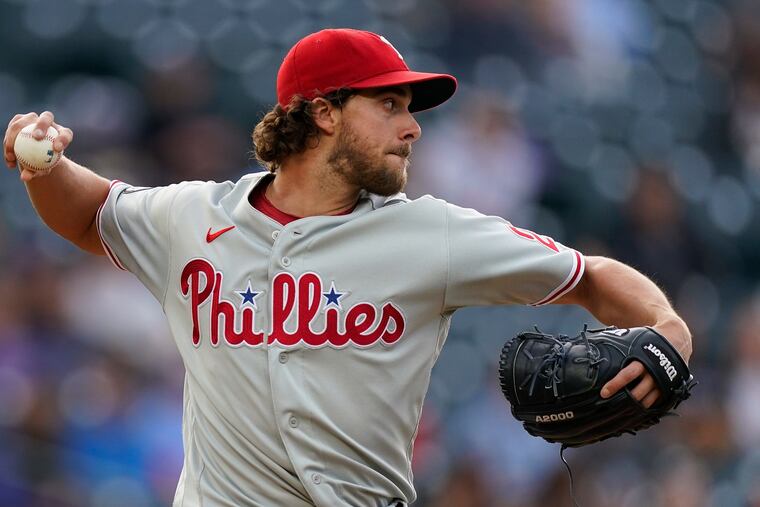Aaron Nola is not an ace. He’s just the Phillies’ No. 1. There’s a big difference. | Marcus Hayes
Nola is the Phillies' top starter, and that's fine. They haven't had an inarguable ace since Roy Halladay in 2012, but then, there are seldom more than a dozen true aces in baseball.

Perhaps this will put to bed, at least for the time being, the notion that Aaron Nola is an “ace” starter. And that’s OK.
The Phillies, on national television, needed Nola to shut down a division rival after a horrible loss to win a three-game series on the road. The Phillies needed Nola salve the wound of an epically painful, 12-inning loss the night before. He did just the opposite. It was the least surprising result of this young season.
Nola lasted 58 pitches, the shortest outing of his seven-year career. He surrendered five runs in four innings to the Braves. It was the kind of performance that will define Nola, for better or worse, for the immediate future if not longer.
This isn’t Aaron Nola “hate.” This isn’t piling on. Every town wants its own ace, but not every town has one. Nola? He’s very good, and sometimes great, but hardly ever dominant. He’s a No. 1 starter on this team, but he’s not pitching royalty: more Cole Hamels than Gerritt Cole.
No, Hamels wasn’t an ace, either. He is, however, proof that you can win a World Series without one, as he did as the Series MVP in 2008.
Really, the Phillies haven’t had an inarguable ace since 2012, when Roy Halladay led the majors with eight complete games, a 2.20 FIP — Fielding Independent Pitching — and finished second in the Cy Young Award voting, which he’d won in 2011. (There’s an argument to be made that Cliff Lee was ace-ish in 2013, but he was always more Nola/Hamels than Halladay/Cole).
Nola, like Hamels, is the sort of pitcher who will often deliver that “one bad pitch” that turns a tide. Aces do this occasionally, not often. He delivered “one bad pitch” to Phillies killer Pablo Sandoval on opening day, and his two-run homer tied the game — an event muted by the Phillies’ eventual win. Nola has delivered lots of bad pitches since, and before.
Quality aces
The best definition of an ace: a pitcher who, over several seasons, the other teams fear. Justin Verlander. Clayton Kershaw. Jacob deGrom. Sometimes teams have two, as the Diamondbacks and Red Sox did when Curt Schilling paired first with Randy Johnson and then Pedro Martinez. Other teams respect Nola. They do not fear him.
Like most of the sensible baseball people I know, I’m more interested in a player who gives you a chance to win than in granular, imperfect metrics. I don’t much like the “quality start” category either: six innings, three or fewer earned runs. It’s an agent-manufactured category of measuring efficiency, and it is useless when trying to measure dominance; however, it is useful for gauging simple proficiency.
» READ MORE: Phillies finally get a day off following two tough losses to the Braves | Extra Innings
Since 2019, Nola failed to manage a quality start in 22 of 54 starts. That’s more than 40% of the time. That’s not horrible, but that’s not an ace. What’s an ace? Since 2019, Gerritt Cole failed to manage a quality start just seven times in 52 starts.
Does that seem an impossible standard? Sure. That’s why an “ace” and a “No. 1 starter” are very different animals.
There might not be more than a dozen aces in baseball at any given time. There might not be 10.
There are a lot more Aaron Nolas.
» READ MORE: Aaron Nola’s ace effort lifts Phillies to a series victory over Cardinals | Bob Brookover
Appreciate ya
Again, this should not be construed as any sort of criticism of Nola himself; rather it is a disagreement with those who would promote Nola as more than he really is. After all, Aaron Nola isn’t some self-promoting prima donna campaigning for accolades. That’s Joel Embiid.
He’s a very good pitcher, historically effective against right-handers and left-handers, durable, gets deep into games, scrambles well, and he pitches acceptably regardless of the time of year. It is Moments that seem to get him. Moments like Sandoval’s in the season opener.
Moments like Sunday Night Baseball on ESPN.
The Phillies’ formless, desperate bullpen blew three saves in Saturday night’s loss. It was the sort of performance that can convince a team like the underachieving Braves that the overachieving Phillies shouldn’t be within five games of them in the standings instead of a half-game behind. A loss like Saturday night’s can awaken a sleeping giant.
» READ MORE: Phillies prospect Kevin Gowdy hopes new pitch rekindles his big-league dream | Bob Brookover
Maybe it did. Nola needed to knock that giant out. He did not.
In every sport, great players — elite players — win a game here and there by themselves. Elite players. Players like Phillies slugger Bryce Harper, or, yes, Embiid.
Good players, meanwhile, routinely make large contributions to wins.
There is a vast difference between elite players, like aces, and good players. Aaron Nola is the latter.